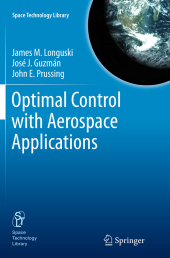 Neuerscheinungen 2016Stand: 2020-02-01 |
Schnellsuche
ISBN/Stichwort/Autor
|
Herderstraße 10
10625 Berlin
Tel.: 030 315 714 16
Fax 030 315 714 14
info@buchspektrum.de |

Jose J. Guzmán, James M. Longuski, John E. Prussing
(Beteiligte)
Optimal Control with Aerospace Applications
Softcover reprint of the original 1st ed. 2014. 2016. xx, 273 S. 91 SW-Abb. 235 mm
Verlag/Jahr: SPRINGER, BERLIN; SPRINGER NEW YORK; SPRINGER 2016
ISBN: 1-493-94917-9 (1493949179)
Neue ISBN: 978-1-493-94917-5 (9781493949175)
Preis und Lieferzeit: Bitte klicken
This book introduces the elementary computational techniques of optimal control in aerospace engineering. Throughout, use is made of the time-optimal launch of a satellite into orbit as an important case study. Includes problems and an online solution manual.
Want to know not just what makes rockets go up but how to do it optimally? Optimal control theory has become such an important field in aerospace engineering that no graduate student or practicing engineer can afford to be without a working knowledge of it. This is the first book that begins from scratch to teach the reader the basic principles of the calculus of variations, develop the necessary conditions step-by-step, and introduce the elementary computational techniques of optimal control. This book, with problems and an online solution manual, provides the graduate-level reader with enough introductory knowledge so that he or she can not only read the literature and study the next level textbook but can also apply the theory to find optimal solutions in practice. No more is needed than the usual background of an undergraduate engineering, science, or mathematics program: namely calculus, differential equations, and numerical integration.
Although finding optimal solutions for these problems is a complex process involving the calculus of variations, the authors carefully lay out step-by-step the most important theorems and concepts. Numerous examples are worked to demonstrate how to apply the theories to everything from classical problems (e.g., crossing a river in minimum time) to engineering problems (e.g., minimum-fuel launch of a satellite). Throughout the book use is made of the time-optimal launch of a satellite into orbit as an important case study with detailed analysis of two examples: launch from the Moon and launch from Earth. For launching into the field of optimal solutions, look no further!
Acknowledgments.- Preface.- Chapter One: Parameter Optimization.- Chapter Two: Optimal Control Theory.- Chapter Three: The Euler-Lagrange Theorem.- Chapter Four: Application of the Euler-Lagrange Theorem.- Chapter Five: The Weierstrass Condition.- Chapter Six: The Minimum Principle.- Chapter Seven: Some Applications.- Chapter Eight: Weierstrass-Erdmann Corner Conditions.- Chapter Nine: Bounded Control Problems.- Chapter Ten: General Theory of Optimal Rocket Trajectories.- Appendices.- Bibliography.
From the book reviews:
"The book provides an accessible and comprehensive exposition and introduction to methods of optimal control and their use in aerospace applications. It is oriented towards those who are beginning their study of optimal control, those who are interested in exploiting optimal control theory to treat specific problems arising in applications, in general, and to practitioners in the area of aerospace engineering, in particular." (Ilya Kolmanovsky, Mathematical Reviews, November, 2014)
"This textbook addresses applications of the calculus of variations to aerospace problems. ... This text should be useful to graduate students in aerospace engineering. The book is equipped with several Matlab codes in the appendices." (Alexander Mikhailovich Kovalev, zbMATH, Vol. 1297, 2014)


